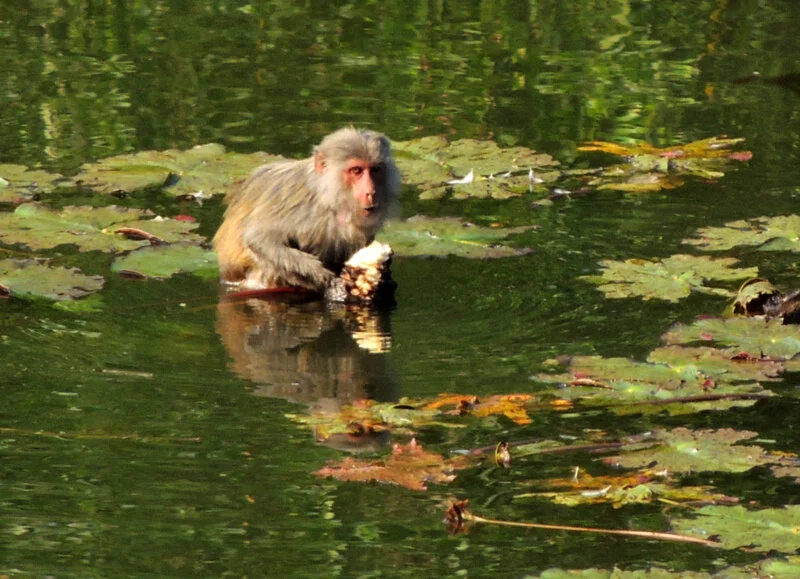Homage to Flooded Habitats
By Katarzyna Nowak, Safina Center Fellow
Unless you believe stories that beleaguer evolution such as the “Aquatic Ape Hypothesis” you know that we primates—human and non-human—are land mammals by design. We are either solely or largely terrestrial or arboreal, and neither aquatic nor semi-aquatic (although Malaysia’s “sea gypsies” for whom marine animals are a staple food and Japan’s hot-spring-immersing macaques push the limits of “semi-“). And yet, we need water and depend on a variety of water-rich habitats.
Variations of the notion “water is life” exist in many different languages, including “maji ni uhai” (Swahili), “el agua, fuente de vida” (Spanish), and my own native language “woda to życie” (Polish).
Non-human primates (from herein primates) including apes—our closest living relatives—and species of monkeys, lemurs, lorises, and tarsiers, have over recent decades been observed in association with water-rich and flooded habitats. These habitats range from freshwater and brackish swamps, to intertidal zones, to riverine, lake- and beach-side forests. For some species, they offer relatively human-undisturbed refuge, for others, sleeping sites, drinkable water, thermal respite, and important food resources including fallback foods.
Spot the Zanzibar red colobus at high tide in the mangroves. Photo: Katarzyna Nowak
I draw here on a volume that’s in print as I write this. Together with two colleagues—Adrian Barnett and Ikki Matsuda—we have worked to compile observations of primates in flooded habitats into a single piece of work. It has been a passion project that, after many years, is finally concluding. My hope is that it doesn’t stop with the book but that the project can inspire a new wave of conservation attention and engender respect for the relationship that primates (us included) have with water.
Flooded habitats occupy the space between terrestrial (terra firma) and aquatic realms. Some are flooded on a permanent basis, others seasonally, including alongside river margins and deltas. Plants that grow in these areas are adapted to the flooding. But few primate species show adaptations to water, perhaps with the exception of the proboscis monkey: it has partially webbed back feet. Others, for example rhesus macaques in the Sundarbans interact with and cross water wittingly including by swimming between islands and responding “rhythmically” to tidal fluctuations, as observed by Jayanta Mallick in India and Bangladesh. Still others avoid water and cross it hesitantly, even grudgingly, for example Guinea and olive baboons studied and filmed by Anh Galat-Luong and Gerard Galat in West Africa.
Rhesus macaque. Photo: Subrata Pal Chowdhury
Meanwhile, says my friend and animal play researcher Isabel Behncke who researched apes in DR Congo, “It’s a great paradox that bonobos play with water since they avoid it, and avoid getting wet, crossing rivers by using trees rather than wading. And yet, some individuals play and interact with it in exploratory ways.”
Association of primates with water—for survival, exploration and play—is of course not new; however today it’s varied and not without risk. Flooded habitats face threats, some common across habitats and others specific to flooded zones in particular. Fire and conversion of natural vegetation for agricultural activities are two threats in the Pantanal; oil extraction threatens the Colombian Amazon and the Niger Delta. Rising sea levels are threatening mangroves and river deltas. And, as Colin Chapman points out in his Foreword to our book, the global demand for water is rising because of demands for agriculture and energy development (hydropower) creating incentives to draw water away from flooded habitats and wetlands, thus depriving them of the very thing that defines them.
P. kirkii adult female in Uzi Island mangroves. Photo courtesy: Katarzyna Nowak
We have only begun to understand and appreciate the significant roles played by flooded environments in not only primate biogeography, but also in our and other primates’ evolution. This is emphasized by Matt Sponheimer and colleagues according to whom, “it can be argued that primate associations with water were there from the beginning.” This “antiquity” is based on fossils of the oldest (60 million year old) “euprimate,” discovered on the shores of Morocco. From lakes to floodplains, our association with water has continued. We and other primates are sustained in the vicinity of water and water-rich habitats that yield sedges, grasses, aquatic plants, underground storage organs, as well as protein-rich foods such as crabs, oysters, mollusks, sought after by patas monkeys in West Africa, capuchins in Brazil, macaques in the Sundarbans, and of course, by us.
Olive baboon foraging for mussels in the Arli River, Burkina Faso. Photo: Galat-Luong A.-IRD




